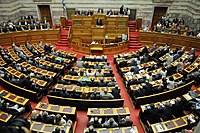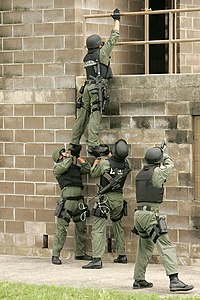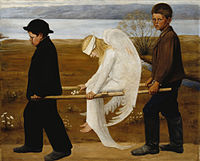Brilliania
Republic of Brilliania Errepublika Berilinako | |
|---|---|
Coat of arms
| |
| Motto: Mantendu egingo dugu We will maintain | |
| Anthem: The Three Sailors "Hiru Marinel" | |
| Capital | Saranegertu |
| Largest | Martirien Herria |
| Official languages | Brillian, Iparinan |
| Ethnic groups (2016) | |
| Demonym(s) | Brillian |
| Government | Unitary presidential republic |
• Lehendakari | Haran Lukenen Elexalde |
| Independence from the Aeian Socialist Union 1981 | |
• Unification of Brillian territories | 964 |
• Introduction of Alydianism and end of isolation | 1676 |
• Assasination of Prince Ilurdo | 1915 |
• ASU takes over | 1916 |
• Proclamation of Independence held | 1979 |
• Blue Revolution | 2000 |
| Population | |
• 2017 census | 16,518,815 |
| GDP (PPP) | 2017 estimate |
• Total | $487,998,832,730 |
• Per capita | $29,542 |
| GDP (nominal) | 2017 estimate |
• Total | $395,873,401,475 |
• Per capita | $23,965 |
| Gini (2016) | medium |
| HDI (2017) | very high |
| Currency | Brillian Florrin (BFL) |
| Time zone | UTC+1 (Central Asuran) |
• Summer (DST) | +2 |
| Date format | yyyy-mm-dd |
| Driving side | right |
| ISO 3166 code | BR |
| Internet TLD | .br |
Brilliania (Brillian: Berilinako), officially the Republic of Brilliania, formerly the Brillian Republic (Brillian: Errepublika Berilinako) is a sovereign state in Eastern Asura bordered by the Gulf of Sclavonia and the nations of Miersa, Veleaz and Dreyvisevich. Brilliania consists of 10 provinces, 9 regular provinces and the specially administered capital of Saranegertu. It is an unitary semi-presidential republic with around 16.5 million inhabitants. Ethnic Brillian people, which speak the isolated Brillian language make up 79% of the population, with a significant minority of Iparinans from the southeastern region of Iparina.
The territory of Brilliania has been populated for several thousand years, with the first evidence of civilization being traced to 3000 years ago. The ancient Herritxa civilization existed until 600 BC. The language which was spoken by the Herritxa civilization is currently still unknown.
Brilliania was pagan until the 11th century, practising a religion called Marism. Alydianism was introduced by western Alydian crusaders, in the form of Orthodox Alydianism. It was partially supplanted in the 17th century by Puritan Alydianism because of Veleazan missionarries. The contact with Veleazan missionaries caused an exchange of Veleazan words in the Brillian language while Brillian words also entered into Veleazan.
Brilliania was ruled by a monarchy for almost a thousand years, starting when Prince Ganiz unified several Brillian towns in the year 964, and ending with the execution of Prince Ilurdo by communists in 1931. However, the Prince became mostly ceremonial in 1887, with the creation of the first parliament of Brilliania. The parliament was unique in the fact that every adult man was able to vote in elections. Female suffrage did not exist prior to Brillian independence in 1979.
In 1915, profiting from the anarchy started by Prince Ilurdo's execution, and a bombing on the Parliament while it was in session, the Aeian Socialist Union and communist militia succesfully conquered Brilliania. This started 46 years of oppression by the communists, with the execution of up to 14,000 prominent individuals.
Independence was proclaimed on the 6th of December in the year 1979, causing the Brillian government in exile to join the secessionist side in the ASU Civil War. The Civil War was bloody, with 15,000 people, mostly civilians, dying. One of the most prominent murders in the ASU Civil War were the Sirizio Defenestrations, where Communist spies in Asura killed 15 diplomats in embassies of the in-exile government of the Republic of Brilliania by throwing them out of windows.
After the Civil War, Brillian independence was internationally recognized. Brilliania is a developed country with a high-income service-based economy, which grew massively between 2002 and 2015 during the "Brillian Boom". It ranks very highly in the Human Development Index. Brillian citizens have a high quality of life, assisted by massive technology investments since the Blue Revolution, low-cost education and a state healthcare system. Despite governmental investments in social security, income inequality is relatively high, with a medium ranking for Gini.
History
Before 964
- Iparinan migration from the north - many rivalling tribes/cities
Princedom of Brilliania (964 - 1933)
- Prince Ganiz unifies tribes - Some small wars with neighbours, nothing major - Mostly dominated by Veleaz - Part of Veleaz during GW
ASU occupation (1916 - 1979)
- Events in Veleaz and Miersa inspire Brillian revolutionaries, combined with the death of King Ilurdo - seperatists proclaim independence in 1979 during start of asu civil war - provisional government formed for 3 years
Republic of Brilliania (1979- current)
After the ASU Civil War ended, Brilliania started its transition to democracy. The ceremonial renaming of the city of Sirizio (named after the first president of the Brillian Soviet) to Martirien Herria (Town of the Martyrs) marked the symbolic end of socialism in Brilliania. The first free elections resulted in the big-tent opposition movement Brillian Forum for Democracy winning, beating the communist heirs Social Democratic Movement by a landslide. Rapid introductions of economic changes and constitutional changes including the addition of a directly elected president proved unpopular, with the second elections in 1984 giving the Social Democrats an absolute majority in the Muntaia. Elections between 1988 and 2001 caused the Forum to gain popularity, becoming a dominant party. Many Asuran observers considered Brilliania to have one of the most antiquated and conservative constitutions in Asura.
Protests in 2002 caused by the rising unpopularity of the Forum with younger generations and the growing levels of liberalization of society caused the downfall of the Forum with newer parties such as the Hitzarmen Party, Elkarrekin Movement, Alliance of Young Patriots and the Brilliania Not For Sale Movement gaining rapid popularity. The Democrats of Brilliania won a plurality in the early elections in 2003, allowing it to make a grand coalition with the Elkarrekin Movement to have the two-thirds supermajority required to amend or remake the constitution. The 2005 constitution introduced laws liberalizing the Brillian political atmosphere and modernizing the constitution to reflect the liberalization of the Brillian society.
The two worst terrorist attacks in Brillian history occurred in 2018. In August, a suicide bombing by the far-left terrorist organization Black Brigades at the Zamalloa Hall in Saranegertu causing 49 deaths including influential politician Amaia Sarasketa. On the 6th of December, a hostage situation at the Ortzadar Special High School in Martirien Herria caused the deaths of 672 students.
Geography
Brilliania is a relatively low-lying country, with parts of the northern coast being below sea level. The southern parts are hillier, including the capital city of Saranegertu. The average national elevation is around 30 metres. The highest point of Brilliania is the 560-metre high Saran Peak, which is close to Saranegertu. The Saran Peak is easily climbable and is a popular spot for tourists. Saranegertu itself is one of the highest-elevated cities in Brilliania, being around 350 metres high.
Climate
Environment
Politics and Government
The Republic of Brilliania is administered as a unitary presidential republic governed by the laws defined in the Fourth Constitution of the Republic, which was signed in 2005. The parliament of Brilliania is the unicameral Legebiltzarrak. The highest role in Brillian politics is the Lehendakari, which is elected directly by the people using the two-round method. The current Lehendakari is Haran Lukenen Elexalde, representing the Democrats of Brilliania.
The Lehendakari may not be a member of the Legebiltzarrak, but must be appointed via an internal party election. They have a large amount of influence in the Legebiltzarrak, including the ability to submit law proposals. However, they are not allowed to vote in the Legebiltzarrak.
All 270 members of the Legebiltzarrak are elected by the Brillian populace using national party-list proportional representation using the Sainte-Laguë method. The Legebiltzarrak meets in the former royal palace in Martirien Herria.
Legebiltzarrak
The Legebiltzarrak is the unicameral legislature of the Republic of Brilliania. It consists of exactly 270 (180 before 2005) members which are elected using party-list proportional representation using the Sainte-Laguë method of proportional representation. The Lehendakari is allowed to make law proposals and parliamentary motions, the latter only if they are physically in the Parliament.
20 MPs, or the Lehendakari alone, may propose a parliamentary motion to expel a member if he breaks parliamentary protocol. The most recent parliamentary motion for expellation of a MP was on 11 October 2018, when 197 MPs voted in favour of a presidential motion to expel the independent far-right MP Martitz Urdaki after he expressed his sympathy towards the culprit of the 2018 Jakóbgard attacks.
Since 2005, the parliamentary rules have included provisions for a weekly parliamentary question session for the Lehendakari, according to Midrasian standard.
Parties
Since the fall of communism, Brilliania has a multi-party system. The most recent legislative election will occur on 10 May 2019. International observers consider Brilliania to have a two-party system, with the Elkarrekin Movement and the Democrats of Brilliania holding nearly 90% of the legislature in 2015.
The Elkarrekin Movement is a successor to the Social Democratic Movement, which was the heir of the Communist Party of Brilliania. However, Elkarrekin is considered more moderate than the Social Democratic Movement. It supports stronger anti-discrimination laws, legalization of same-sex marriages, secularism, and improved coöperation with the CDN. It is associated with the colour amaranth.
The Democrats of Brilliania is a conservative party, heir of the Brillian Forum for Democracy. They are the largest right-wing party in Brilliania. Its policies include tax breaks for families with 4 or more children, strong adherance to traditional Alydian values, simplification of tax laws, higher Ertzaintza presence in larger towns and scepticism towards the CDN. Its official party colour is light blue.
Law and judicial system
The judicial system in Brilliania is based off civil law. There are three kinds of courts: district courts, regional high courts and the Supreme Court (Kuria). The Kuria is based in Saranegertu.
Law enforcement in Brilliania is operated by the Ertzaintza, which carries out all major police duties such as investigation, patrol activity, traffic policing and border control. The Ertzaintza is highly trained and is led by the National Commissioner of Law Enforcement, supervized by the Interior Minister. It is divided into regional and city divisions. The elite force of the Ertzaintza, the semi-militarized Jendarme, is used for riot control and critical incidents.
Military
Foreign Relations
Economy
Energy
Industry
Infrastructure
Transport
Demographics
According to the most recent national census, a total of around 16.5 million people live in the Republic of Brilliania. Most citizens live in Kostaldea, Hiriburuko Auzoa and Iparina provinces. The largest city is Martirien Herria (formerly known as Sirizio), which houses around 2.7 million people and was the former capital of Brilliania until 1950. The capital city is Saranegertu, which is administered as a province called Hiriburuko Auzoa which is an enclave fully in Iparina province.
Brilliania is considered a relatively homogenous nation, with the most major groups being the Brillians and the Iparinans. Other minorites include Sclavonics, Veleazans and Miersans, with the latter two mostly consisting of refugees from regional tensions.
Education
Education in Brilliania consists almost fully of public education, with standards being created by the Ministry of Education. Preschool is optional but highly recommended, and 97% of Brillian children between the ages of 3 and 6 attend preschool. Schooling generally starts at age 7 and is mandatory until the age of 17. At the age of 12, students must do the EPA exam which decides which of the 3 levels of secundary education a child will go to.
The three levels of secondary education in Brilliania are called Lower Secondary, Middle Secondary and Higher Secondary. Lower Secondary is a form of vocational education and prepares a student for future work. It takes 3 years and exams are performed at the age of 15.
Middle Secondary is a form of education mostly meant for preparation for future education or work. It takes 4 years and exams are performed at the age of 16.
Higher Secondary is the most prestigious form of secondary education. It prepares a student for the Matura and university-level tertiary education. It takes 5 years. Higher Secondary students are given Matura at the age of 17.
Brillian education is well-known for being one of the strictest in Asura; there are heavy punishments for truancy and there are very strict dress code laws.
Religion
Religion in Brilliania (2016)
Culture
Music
Brilliania has had several musical developments in its history. A very common type of Brillian music is the "Bizitza kantua" (Life song). These life songs often are about subjects of lost ones or loneliness. They have a simple melody and a straightforward musical structure. A common element in life songs are accordions and guitars. Despite the cultural liberalization since Brillian independence, they are still very popular.
Brillian independence in the 80's caused cultural liberalization which is also marked in Brillian music. Music moved in a more positive way, shifting away from tradition and moving into internationalized territory with songs by bands such as Bonba becoming huge hits in Brilliania. The shift to internationalized music has continued in recent years, coinciding with the general liberalization of Brillian society.
Other foreign music styles such as jazz are also popular. The jazz singer Salbatzaile Tzobiral gained international praise in 2016 after winning the Aeiavision Song Contest with his self-penned song "Maitasuna Bai". Rock and metal are also popular international music genres in Brilliania, although artists making music in these genres have recieved severe opposition from religious organizations for promoting atheism.
Cuisine
Cuisine is a big part of the Brillian culture, with cooking being regarded as a communal event especially at special occasions. Brillian cuisine is influenced by its history and geography, especially the historical releations with Veleaz. In Kostaldea, fish dishes are widespread, while in the south meat is preferred. Traditional dishes are often marked by their simplicity, with most dishes consisting of less than 5 ingredients.
An unusual food in the north is Sareagarratza, which is a lightly-salted fermented fish. It is renown for its highly repugnant smell.
In Iparina, the Veleazan influence is most visibly in the prominence of paprika. Most dishes from Iparina are stewed, with beef being the most popular. Nationwide-renowned Iparinan dishes are erreta and kullas (also known as gulyás). Both are forms of beef stew featuring paprika as a key ingredient.
A common occurrence in Brilliania are the so-called txoko, which are closed gastronomical societies for men. Txokos doubled as speakeasies during ASU rule - the communist government in Brilliania did not monitor txokos. Most txokos have their own constitutions featuring rules the members must agree to. Txokos are very common institutions: The city of Saranegertu, with more than 2 million citizens, has over 1,500 txokos with over 200,000 members in total. Most txokos are very conservative - traditional clothing is required and women are banned from entering because cooking is often regarded as a male activity in Brilliania. In recent years the so-called txoko sozialak, or social txoko, have been started in most major cities. Social txokos allow women, and have liberal dress codes. Txokos are also a common place for political debates.







